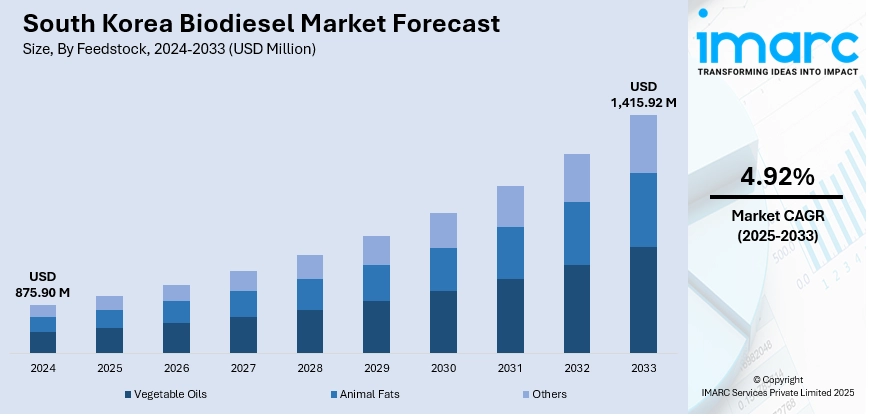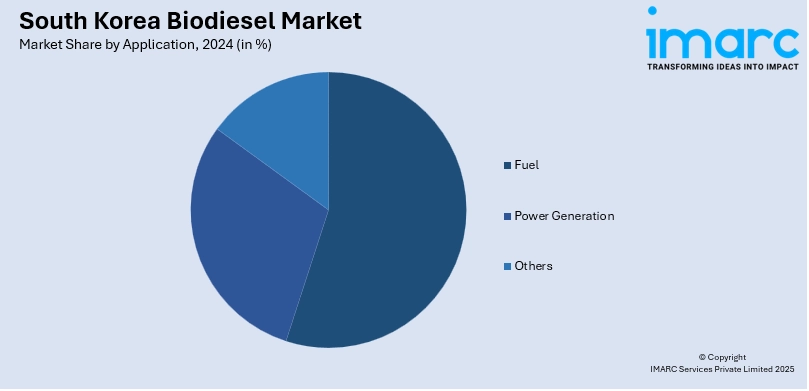
South Korea Biodiesel Market Size, Share, Trends and Forecast by Feedstock, Application, Type, Production Technology, and Region, 2025-2033
South Korea Biodiesel Market Overview:
The South Korea biodiesel market size reached USD 875.90 Million in 2024. The market is projected to reach USD 1,415.92 Million by 2033, exhibiting a growth rate (CAGR) of 4.92% during 2025-2033 At present, the government is vigorously encouraging the adoption of biodiesel via favorable policies, blending requirements, and incentives to reduce the carbon emissions of the transportation and industrial sectors. Besides this, awareness is being created and job opportunities are being fostered through educational campaigns and policy backing, contributing to the expansion of the South Korea biodiesel market share.
|
Report Attribute
|
Key Statistics
|
|---|---|
|
Base Year
|
2024
|
|
Forecast Years
|
2025-2033
|
|
Historical Years
|
2019-2024
|
| Market Size in 2024 | USD 875.90 Million |
| Market Forecast in 2033 | USD 1,415.92 Million |
| Market Growth Rate 2025-2033 | 4.92% |
South Korea Biodiesel Market Trends:
Growing concerns about air pollution and carbon emissions
Rising concerns about air pollution and carbon emissions are positively influencing the market in South Korea. According to industry reports, in 2024, per capita carbon emissions in South Korea were nearly three times the global average. With increasing awareness about the harmful effects of vehicle emissions and industrial pollution on public health and the environment, there is a growing demand for low-emission fuel options. Biodiesel, being a renewable and cleaner-burning fuel, offers a practical solution for reducing particulate matter, sulfur dioxide, and greenhouse gas emissions. The government is actively promoting the use of biodiesel through supportive policies, blending mandates, and incentives to minimize the carbon footprint of the transportation and industrial sectors. Public and private sectors are adopting biodiesel to meet environmental targets and improve sustainability practices. As urban air quality is becoming a critical issue, especially in densely populated cities, biodiesel is gaining acceptance for its potential to support cleaner urban transport systems. Additionally, public pressure and environmental activism are motivating industries and logistics providers to switch to biodiesel as part of their green initiatives. Local production of biodiesel from waste cooking oils and other sustainable feedstocks is adding to its appeal, ensuring a circular economy approach.

To get more information on this market, Request Sample
Rising adoption of renewable energy
Increasing adoption of renewable energy is propelling the South Korea biodiesel market growth. As per the IMARC Group, the South Korea renewable energy market size reached 55.6 TWh in 2024. As the country is investing heavily in expanding its renewable energy portfolio, biodiesel is becoming an essential part of its broader energy diversification strategy. Biodiesel complements solar, wind, and other clean energy sources by offering a liquid fuel option that can be easily integrated into existing fuel infrastructure. Its compatibility with diesel engines allows a smoother transition without requiring major equipment overhauls. Government energy roadmaps increasingly include biodiesel as a key component in achieving long-term sustainability targets. The adoption of renewable energy is also stimulating research and innovations in biofuel technologies, improving production efficiency and feedstock utilization. Companies in logistics, public transport, and construction are shifting towards biodiesel to align with national green energy goals. Educational campaigns and policy support are further generating awareness and promoting employment. As renewable energy is gaining momentum, biodiesel stands out as a practical, scalable, and immediately applicable solution that supports South Korea’s clean energy ambitions while strengthening the country’s industrial competitiveness.Top of FormBottom of Form
South Korea Biodiesel Market Segmentation:
IMARC Group provides an analysis of the key trends in each segment of the market, along with forecasts at the country and regional levels for 2025-2033. Our report has categorized the market based on feedstock, application, type, and production technology.
Feedstock Insights:
- Vegetable Oils
- Animal Fats
- Others
The report has provided a detailed breakup and analysis of the market based on the feedstock. This includes vegetable oils, animal fats, and others.
Application Insights:

- Fuel
- Power Generation
- Others
A detailed breakup and analysis of the market based on the application have also been provided in the report. This includes fuel, power generation, and others.
Type Insights:
- B100
- B20
- B10
- B5
The report has provided a detailed breakup and analysis of the market based on the type. This includes B100, B20, B10, and B5.
Production Technology Insights:
- Conventional Alcohol Trans-esterification
- Pyrolysis
- Hydro Heating
A detailed breakup and analysis of the market based on the production technology have also been provided in the report. This includes conventional alcohol trans-esterification, pyrolysis, and hydro heating.
Regional Insights:
- Seoul Capital Area
- Yeongnam (Southeastern Region)
- Honam (Southwestern Region)
- Hoseo (Central Region)
- Others
The report has also provided a comprehensive analysis of all the major regional markets, which include Seoul Capital Area, Yeongnam (Southeastern Region), Honam (Southwestern Region), Hoseo (Central Region), and others.
Competitive Landscape:
The market research report has also provided a comprehensive analysis of the competitive landscape. Competitive analysis such as market structure, key player positioning, top winning strategies, competitive dashboard, and company evaluation quadrant has been covered in the report. Also, detailed profiles of all major companies have been provided.
South Korea Biodiesel Market News:
- In November 2024, HD Hyundai Oilbank Co., a South Korean crude oil refiner, revealed plans to expand its business beyond fossil fuel-focused operations into bioenergy and the circular economy. The firm’s facility could produce 130,000 tons of biodiesel each year. HD Hyundai Oilbank, along with its four affiliates, including HD Hyundai Chemical Co. and HD Hyundai OCI Co., explored prospects in the bioenergy and circular economy fields. The organization intended to address the rising demand for biodiesel in the country.
- In April 2024, Hyundai Oilbank launched a biodiesel facility in South Korea. Plans and considerations were in place for the biodiesel plant to accomplish co-processing of biofuels at its Daesan refinery, which had a capacity of 520,000 Barrels per day.
South Korea Biodiesel Market Report Coverage:
| Report Features | Details |
|---|---|
| Base Year of the Analysis | 2024 |
| Historical Period | 2019-2024 |
| Forecast Period | 2025-2033 |
| Units | Million USD |
| Scope of the Report |
Exploration of Historical Trends and Market Outlook, Industry Catalysts and Challenges, Segment-Wise Historical and Future Market Assessment:
|
| Feedstocks Covered | Vegetable Oils, Animal Fats, Others |
| Applications Covered | Fuel, Power Generation, Others |
| Types Covered | B100, B20, B10, B5 |
| Production Technologies Covered | Conventional Alcohol Trans-esterification, Pyrolysis, Hydro Heating |
| Regions Covered | Seoul Capital Area, Yeongnam (Southeastern Region), Honam (Southwestern Region), Hoseo (Central Region), Others |
| Customization Scope | 10% Free Customization |
| Post-Sale Analyst Support | 10-12 Weeks |
| Delivery Format | PDF and Excel through Email (We can also provide the editable version of the report in PPT/Word format on special request) |
Key Questions Answered in This Report:
- How has the South Korea biodiesel market performed so far and how will it perform in the coming years?
- What is the breakup of the South Korea biodiesel market on the basis of feedstock?
- What is the breakup of the South Korea biodiesel market on the basis of application?
- What is the breakup of the South Korea biodiesel market on the basis of type?
- What is the breakup of the South Korea biodiesel market on the basis of production technology?
- What is the breakup of the South Korea biodiesel market on the basis of region?
- What are the various stages in the value chain of the South Korea biodiesel market?
- What are the key driving factors and challenges in the South Korea biodiesel market?
- What is the structure of the South Korea biodiesel market and who are the key players?
- What is the degree of competition in the South Korea biodiesel market?
Key Benefits for Stakeholders:
- IMARC’s industry report offers a comprehensive quantitative analysis of various market segments, historical and current market trends, market forecasts, and dynamics of the South Korea biodiesel market from 2019-2033.
- The research report provides the latest information on the market drivers, challenges, and opportunities in the South Korea biodiesel market.
- Porter's five forces analysis assist stakeholders in assessing the impact of new entrants, competitive rivalry, supplier power, buyer power, and the threat of substitution. It helps stakeholders to analyze the level of competition within the South Korea biodiesel industry and its attractiveness.
- Competitive landscape allows stakeholders to understand their competitive environment and provides an insight into the current positions of key players in the market.
Need more help?
- Speak to our experienced analysts for insights on the current market scenarios.
- Include additional segments and countries to customize the report as per your requirement.
- Gain an unparalleled competitive advantage in your domain by understanding how to utilize the report and positively impacting your operations and revenue.
- For further assistance, please connect with our analysts.
 Request Customization
Request Customization
 Speak to an Analyst
Speak to an Analyst
 Request Brochure
Request Brochure
 Inquire Before Buying
Inquire Before Buying




.webp)




.webp)












